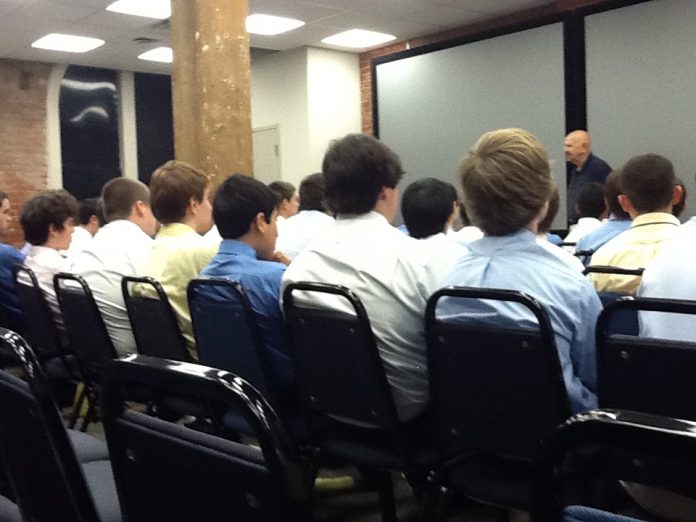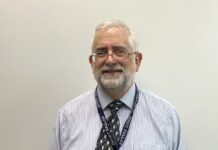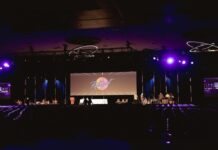Every school year, sophomore teachers in the theology department plan a field trip strictly for the sophomores to the Holocaust Museum of Dallas, located on 211 Record Street in downtown Dallas. The day includes several presentations created by various teachers to reflect on the horrors of the Holocaust. “The trip allows students to reflect upon real world events and consider why ‘faith in action’ is an emphasis at Jesuit College Preparatory,” says theology teacher Jonathan Segal.
Students were organized into two groups by last name. Last names A-O went to the museum first, while the others stayed behind to enjoy presentations by some teachers. One such presentation was created by history teacher Patrick Triplett and displayed how countries like the United States missed many opportunities to save mankind. Another presentation, directed by Director of Diversity Erik Burrell, showed the interested sophomores a documentary of how third graders react to social inequality.
Once at the museum, students packed into a tiny room with two giant screens in the front and a wooden podium. After everyone had taken their seats, Ms. Alice Murray, the president of the Dallas Holocaust Museum introduced herself and welcomed the boys to the museum. She briefly touched upon the subject of the difference between a bystander and an up-stander. Then, she introduced a survivor of the Holocaust who also serves on the Board of Trustees for the museum, Mr. Paul Kessler.
Kessler was born in southwest Czechoslovakia in September of 1939, the year Germany invaded Poland beginning World War II. In 1942 four members of his family, including his father, were taken by the Germans to the Auschwitz concentration camp. In 1944 Kessler’s remaining family heard a rumor that the Germans were coming. They dropped what they were doing, packed up, and fled to the next village.
Mr. Kessler and his family tried to start life anew. However, without further warning, the Germans came and ransacked the village. He remembers the townspeople yelling, “Run! The Germans are here!” The Germans specifically looked for women and children, killing them on the spot. However, Kessler and his mother fled into the surrounding woods as a safe haven, leaving behind their relatives. Later that day, two peasants of the same village found the two of them cowering beneath the brush of the forest. The two peasants ushered Mr. Kessler and his mother to a makeshift hiding hole four feet in height, width, and length.
Over the next six months Kessler and his mother stayed in the hole. Mr. Kessler said that to pass the time, they counted until he reached 10,000. His mother also told him fairy tales and old folk tales every day. The two peasants gave the Kessler pair a bowl of soup and some bread daily. During those brutal twelve months, the two peasants never mentioned that their neighbors were also hiding Kessler’s aunt and uncle in a hole just like their own no more than a football field’s length away.
On May 9, 1945, control of the village he inhabited shifted to the Russians. At long last, someone drove the Germans out of the land. A few Russian soldiers found Mr. Kessler and his mother in the hole and freed them. Living in a hole for almost a year has its consequences. Mr. Kessler said that it was hard for him to adjust to the glowing light of day, struggling to stretch his legs. The peasants that hid them took them over to the other side of the small village, where his aunt and uncle were hiding.
At the very end of his speech, Mr. Kessler pulled out a piece of laminated paper and held it up for everyone to see. It was an official piece of paper from the Auschwitz Records Office. It showed the exact date and time of his father’s arrival at the camp in 1939 and his untimely death in April of 1942.
After the presentation, students were dismissed from the auditorium to the lobby area of the museum, where they grabbed a clipboard, a pencil, and an audio player to guide them on a tour. During the course of the hour, the students observed and discussed the artifacts on display at the museum. “It was eye-opening,” said Patrick Finnegan ’14. “It gave me an opportunity to reflect on the conditions around the world,” added Nick Hayes ’14.
During 9th period, the whole sophomore class gathered together as a community to have a prayer service led by sophomores Sean Badger, Jonathan Lacey, and Justin Rotich. Both Lacey and Rotich shared touching stories about their lives that applied to the topic of suffering and discomfort. Math teacher Joe Nava played his guitar during the prayer service, which added fun, yelling, and clapping to the service. At the very end, the sophomores were asked to write thank you letters to Paul Kessler for being kind enough to volunteer his time.






